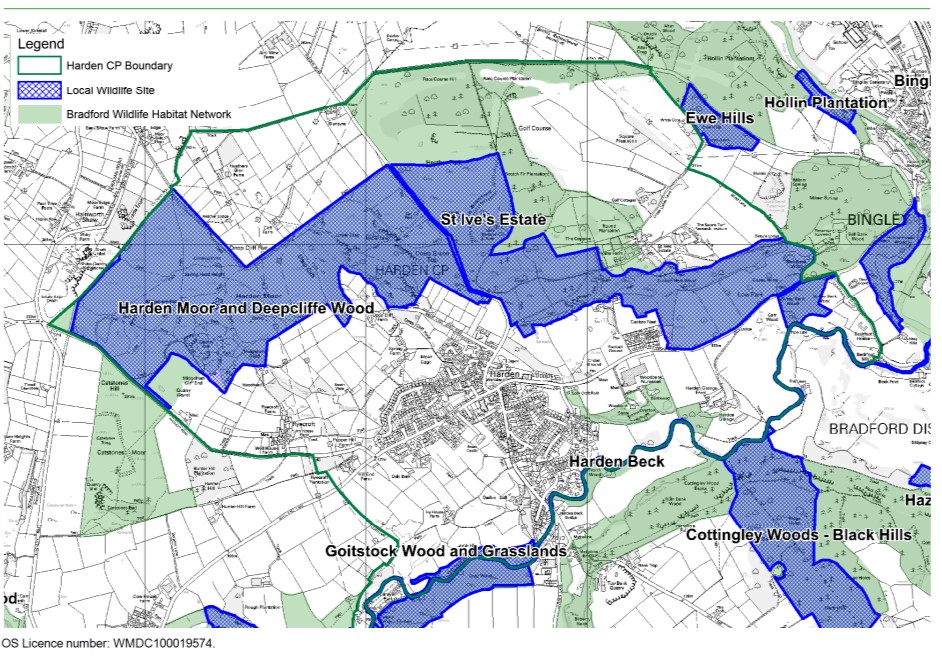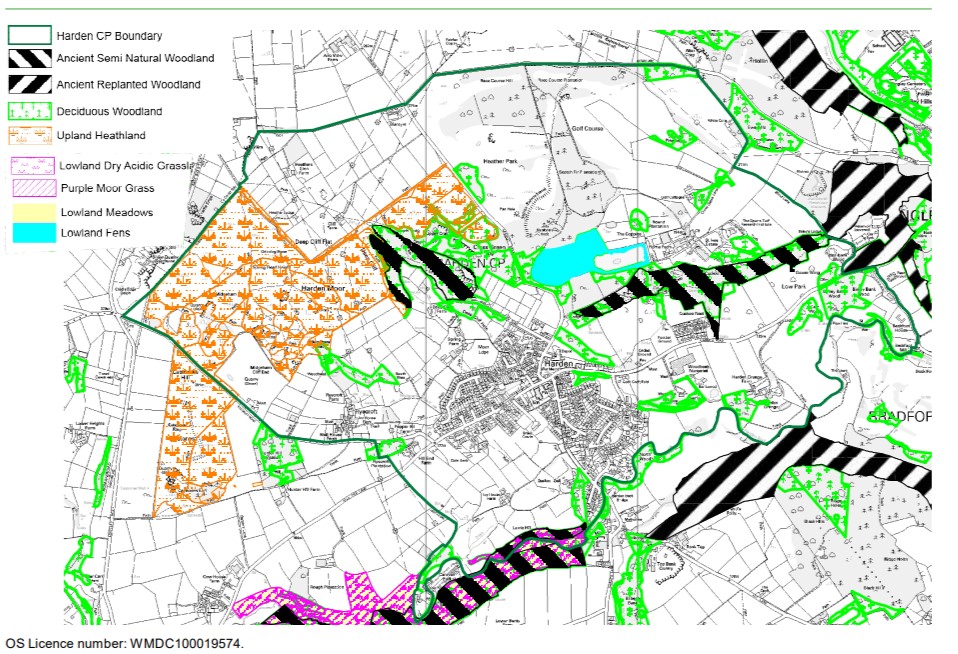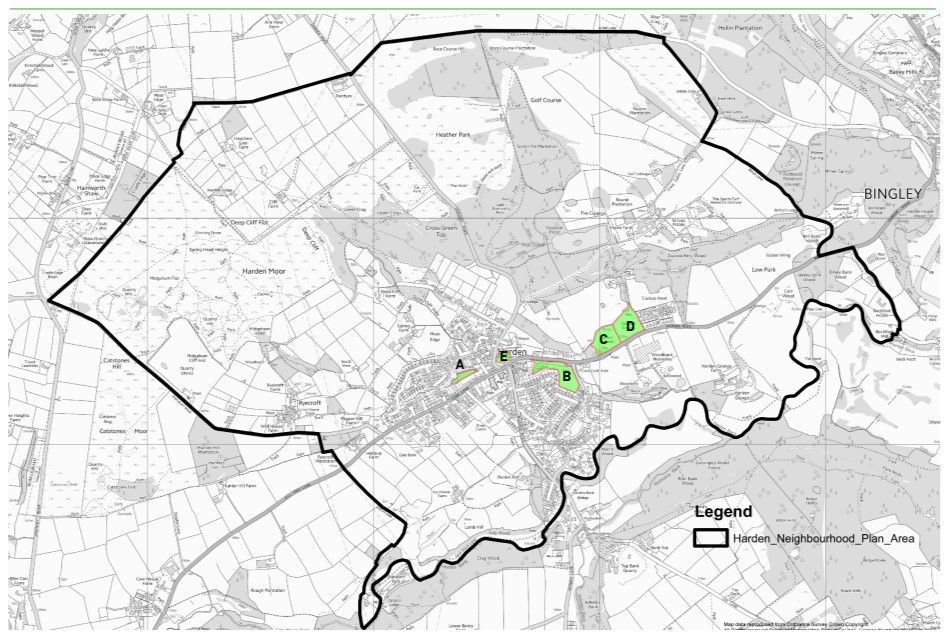Harden Neighbourhood Development Plan - Regulation 16 Consultation
5. GREEN SPACES
5.0 INTRODUCTION
5.0.1 Harden has a rich variety of natural assets and open and green spaces that contribute to the health and wellbeing of residents and visitors, in addition to supporting biodiversity. This includes ancient and semi-natural woodlands, moorlands, meadows, water courses, grasslands, and pastures. Many of these sites are designated as Local Wildlife Sites and fall within the Local Wildlife Network due to their importance in supporting flora and fauna.
5.0.2 These spaces support recreational and leisure activities and contribute greatly to the tranquillity and rural character of Harden.
5.1 COMMUNITY ENGAGEMENT IDENTIFIED THAT:
- The rural nature, countryside and green spaces were the 2nd most popular response to what people like most about Harden.
- Green spaces was the most important issue when people were asked what the Neighbourhood Plan should cover.
5.2 KEY OBJECTIVES:
- Protect and, if possible, enhance green spaces and natural assets
- Secure green infrastructure as part of new developments and protect existing green infrastructure provision
- Encourage the connection of separate green spaces in Harden to create a series of interlinked natural assets into the wider environment forming wildlife and biodiversity corridors
Some of the proposals or projects identified in this section could be delivered locally through volunteer groups or other organisations as part of the Harden Village Council Plan.
POLICY HNDP15: GREEN INFRASTRUCTURE
New developments are strongly encouraged:
- to include provision of green infrastructure, and where possible, connect with the existing Wildlife Habitat Network and/or Local Wildlife Sites;
- not to sever existing green infrastructure networks including Local Wildlife Sites or the Wildlife Habitat Network;
- to achieve biodiversity net gain;
- include green infrastructure that supports and enables the free movement of wildlife such as hedgehog gaps, and include boxes for bats, birds and insects.
- to ensure that the design and management of green infrastructure respects and enhances the character and distinctiveness of an area with regard to habitats and landscape types. Planting that is beneficial for pollinators and wildlife is preferred.
5.2.1 Green infrastructure is a broad-term used to describe natural and semi- natural features of all scales within and between towns and villages from street trees and planting up to rivers, woodland and moorland.
5.2.2 Bradford Council Strategic Core Policy SC6 considers Green Infrastructure as land which already contributes towards, or has the potential to contribute towards the following:
- Retention, creation and enhancement of important habitats and ecological networks.
- Resilience to climate change and sustainable design.
- Important attributes of natural green space, connectivity to other green spaces and a local need for open space.
- Valued landscapes and local distinctiveness and amenity, particularly within the urban core.
- Historic parks and landscapes and the setting for heritage assets.
- Improving opportunities for walking, cycling and horseriding, establishing strategic green links and enhancing the rights of way network in urban and rural parts of the district.
This policy seeks to achieve aims & objectives 4.
This policy aligns with CBMDC adopted core strategy 2017 policy EN2, SC6,
5.2.3 Harden includes many sites that are designated as Local Wildlife Sites or are within the Local Wildlife Network as well as falling under other classifications of green infrastructure.
Local Wildlife Sites:
- Harden Moor
- Deepcliffe Wood
- St Ives Estate
- Goit Stock Wood & Grasslands
- Harden Beck
- Cuckoo Nest Wood
Wildlife Habitat Network:
- St Ives Estate
- Woodbank
- Harden Grange
- Cuckoo Nest Wood
Managed green space for local leisure and recreation:
- Harden Park
- Harden Cricket Pitch
- Harden Football Pitch
Water:
- Harden Beck
- Midgram Beck
- The Coppice Pond
Historic setting:
- Green space surrounding Ryecroft Conservation Area
KEY OBJECTIVES
- Connect or reconnect areas of green infrastructure to enable wildlife to move more freely and for humans to enjoy a greater series of interconnected green spaces
- Provide spaces for leisure, recreation and relaxation contributing to and improving mental and physical wellbeing
- Enhancement of a site's multi-functionality and ability to play a key role in climate change adaption and mitigation, carbon capture, improve wildlife and biodiversity benefits, increased food production, and improved water management and flood risk
- Encourage enhancement of sites in line with their strategic objectives in relation to habitats and species. This might include promoting the planting of native broad-leaved trees, planting that is beneficial to pollinators or the inclusion of bat and bird boxes or hedgehog gaps between properties or physical boundaries
- Deliver green infrastructure provision at a variety of scales from domestic, street, neighbourhood, village, district and regional levels.
POLICY HNDP16: HARDEN WILDLIFE & HABITAT NETWORK
Proposals that provide biodiversity enhancements to green spaces in Harden, including connecting or reconnecting separate spaces, especially on the following sites, are encouraged and will be supported:
Local Wildlife Sites & Wildlife Habitat Network sites:
- St Ives Estate
- Harden Moor
- Deepcliffe Wood
- Harden Beck
- Goit Stock wood and grasslands
Biodiversity enhancements should be undertaken in accordance with the biodiversity objectives for each site to ensure its enhancement is appropriate for the species, habitat and landscape classification.
5.2.4 Harden has a rich variety of natural assets including Harden Moor and Deepcliffe Wood, Goit Stock Wood and its Grasslands, St Ives Estate, and Harden Beck. These sites play an important role in supporting biodiversity locally and regionally. They are home to species such as brown trout that breed in Harden Beck, kestrels and willow warblers on Harden Moor, and a wide-range of species at St Ives including deer, badgers, foxes, tawny and little owls, greater spotted woodpeckers, fresh water shrimp and a variety of bats.
5.2.5 The connection and reconnection of green spaces, especially to Local Wildlife Sites and sites within the Wildlife Habitat Network, can help to create wildlife corridors that support the movement of fauna throughout the area.
5.2.6 There are also opportunities to create a series of interlinked green spaces that can contribute to local recreational and leisure activities. The sites play an important role in contributing towards physical and mental health, flood mitigation, and air and water quality. These are expected to be delivered either as part of new developments or through the Harden Village Action Plan. Opportunities to work with neighbouring farmers and landowners to achieve these benefits on surrounding privately owned land will be sought.
This policy seeks to achieve aims & objectives 4.
This policy aligns with CBMDC adopted core strategy 2017 policy EN2, SC6.
Map 4 - Bradford Habitat Network

POLICY HNDP17: TREE PLANTING
Existing mature trees should be retained as part of any proposed development. Where possible new developments should include tree planting.
New trees should be matched to the site and climatic conditions, with a preference towards native species. These should respect and enhance the biodiversity, character, and distinctiveness of an area with regard to habitats, landscape types and the surrounding built environment.
Any trees which are proposed to be removed due to development should be replaced at a ratio of at least 3:1.
5.2.7 It is expected that local groups, either existing or possible future groups, will liaise with landowners and identify suitable sites for new tree planting in addition to raising funds, obtaining grants and undertaking the work and ongoing management.
5.2.8 The current climate emergency requires urgent attention and planting new trees can help to mitigate against some of these impacts. It is worth noting that management of Harden Moor is ongoing to provide carbon caputre and flood management through the restoration of peat. This is supported and encouraged.
5.2.9 Benefits from tree planting include:
- reducing air pollution
- absorbing CO2 from the atmosphere
- providing shade and shelter
- helping to mitigate against flooding
- improving mental and physical wellbeing
- creating vital homes for wildlife.
5.2.10 Initial engagement identified that:
- The rural nature, countryside and green spaces were the 2nd most popular response to what people like to the question 'What do people like most about Harden?'.
- Green spaces was the most important issue when people were asked what the Neighbourhood Plan should cover.
This policy seeks to achieve aims & objectives 4.
This policy aligns with CBMDC adopted core strategy 2017 policy EN5.
Map 5 - Map of woodlands

POLICY HNDP18: LOCAL GREEN SPACES
The following spaces, as identified on the policies map, are to be designated as local green spaces, and therefore protected from future development.
- Mill pond and surrounding woodland
- Memorial Park off Harden Road
- Cricket ground off Harden Road
- Football pitch off Harden Road
- Village Green Space at Highfell Grove
The enhancement of these sites to improve access, amenity, leisure and recreational opportunities, wildlife or biodiversity opportunities is supported and encouraged.
5.2.11 Full Local Green Space (LGS) assessments have been undertaken and are included in the appendix to this plan. Sites which have been filtered out are also included in the appendix.
5.2.12 Whilst these site are protected from development, development will be considered if:
- The land becomes surplus to requirements
- The loss resulting from the proposed development would be replaced by equivalent or better provision in terms of quality and quantity in a suitable location
- The development is for alternative sports and recreation provision, the benefits of which clearly outweight the loss of the current or former use.
5.2.13 Local Green Spaces are designated sites that are protected from development due to the contribution they make to the local area. There is specific criteria for designating sites so not all green spaces will be suitable for Local Green Space listing. The listing criteria is shown below:
5.2.14 The designation should only be used:
- where the green space is in reasonably close proximity to the community it serves;
- where the green area is demonstrably special to a local community and holds a particular local significance, for example because of its beauty, historic significance, recreational value (including as a playing field), tranquillity or richness of its wildlife;
5.2.15 These green spaces have been suggested by members of the steering group and have been assessed against the criteria set out in the National Planning Policy Framework and National Planning Practice Guidance.
This policy seeks to achieve aims & objectives 4.
This policy aligns with CBMDC adopted core strategy 2017 policies EN1.
MAP OF PROPOSED LOCAL GREEN SPACES


